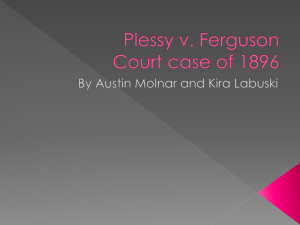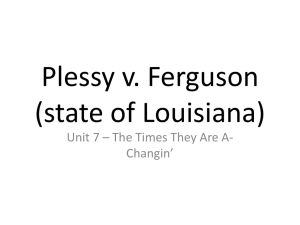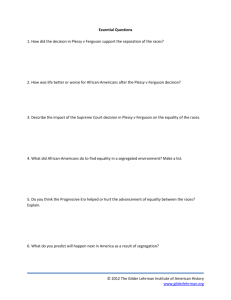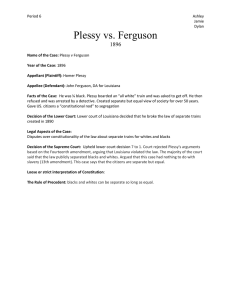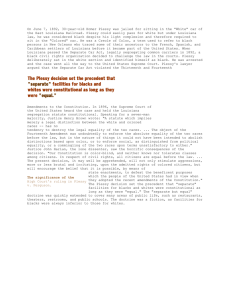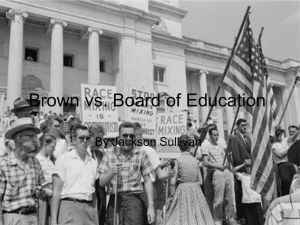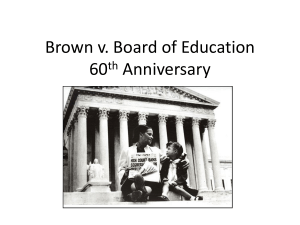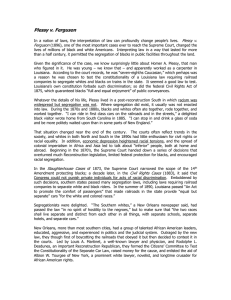Plessy v. Ferguson (1896)
advertisement
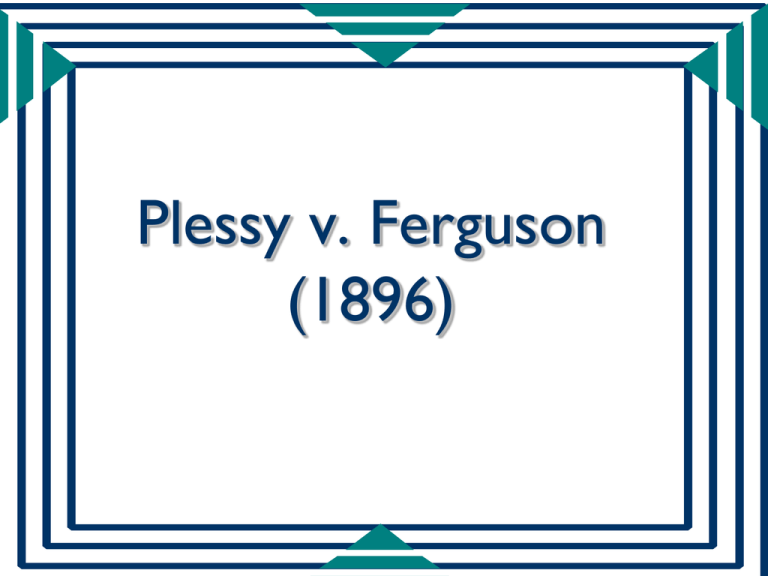
Plessy v. Ferguson (1896) Focus Question • What types of segregation and discrimination did African Americans and other minorities encounter? Segregation and Discrimination • After Reconstruction, southern legislatures passed laws that restricted African Americans’ rights, but prejudice existed nationwide. • Some white southerners tried to restrict African Americans’ right to vote by requiring voters to pay a poll tax and pass a literacy test. • Southern legislatures passed the Jim Crow Laws to create and enforce segregation in public places. • One law requiring separate railway cars for African Americans and whites was tested by Homer Plessy, an African American. His case went to the Supreme Court in Plessy v. Ferguson. They upheld segregation, saying “separate but equal” facilities didn’t violate the Fourteenth Amendment. • In addition to legalized discrimination, strict rules governed social and business interactions between black and white Americans. • The worst outcome of discrimination was lynching, or murder by a mob. Nearly 900 African Americans were murdered between 1882 and 1892 by lynch mobs. Homer Plessy Plessy v. Ferguson • June 7, 1892, was jailed for sitting in the “White” car of the East Louisiana Railroad. • He was a Creole of Color • He was considered black under Louisiana law • By Louisiana law, Separate Car Act of 1892, he was required to sit in the “Colored” car. • A Black civil rights organization challenged the law. • Plessy deliberately sat in the white section and identified himself as black • Lawyers, for Plessy, argued that the Separate Car Act violated the 13th and 14th amendments • Case went to the Supreme Court Opinion of the Court •In 1896, the Supreme Court held the Louisiana segregation statue constitutional. •Speaking for the 7 man majority, Justice Henry Brown wrote: “A statue which implies merely legal distinction between the white and colored races – has no tendency to destroy the legal equality of the two races… The object of the 14th Amendment was undoubtedly to enforce the absolute equality of the two races before the law, but in the nature of things it could not have been intended to abolish distinctions based upon color, or to enforce social, as distinguished from political equality, or a commingling of the two races upon terms unsatisfactory to either. Dissenting Opinion • Justice John Harlan, the lone dissenter, saw the horrific consequences of the decision. • “Our Constitution is color-blind, and neither knows nor tolerates classes among citizens. In respect of civil rights, all citizens are equal before the law… The present decision, it may well be apprehended, will not only stimulate aggressions, more or less brutal and irritating, upon the admitted rights of colored citizens, but will encourage the belief that it is possible, by means of state enactments, to defeat the beneficent purposes which people of the United States had in view when they adopted the recent amendments of the Constitution.” “Separate but Equal” Doctrine • Set the precedent that “separate” facilities for blacks and whites were constitutional as long as they were “equal.” • Covered many areas of public life, such as restaurants, theaters, restrooms, and public schools. • The doctrine was fiction, as facilities for blacks were always inferior to those of whites. Discussion Questions • How did this decision affect segregation laws in the South? • How did Plessy v. Ferguson affect African Americans?
